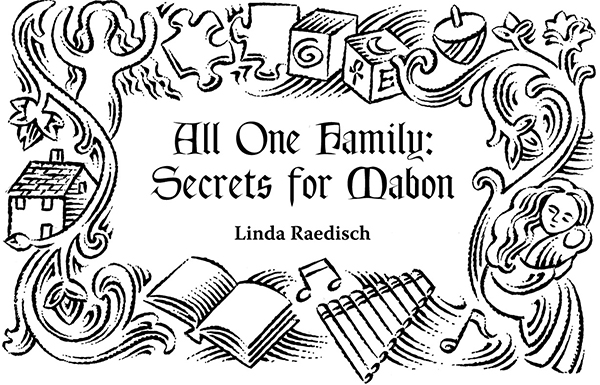
The bulk of this series of articles were written in the month of September, that wonderful time of year when desks creak, book spines crack, and the air is filled with the sweet fragrance of pencil shavings. I may have allowed myself to get carried away by the excitement of the season, which is why, as you may have noticed, I’ve tried to force so many books and reference materials on you. I’m afraid it’s just what comes naturally to me. You’ve probably already guessed that there are books in every room of my home, but I’ll go one further by telling you that I keep my Webster’s New Twentieth Century Dictionary, Unabridged, Second Edition on a stool in the kitchen. Why in the kitchen? Because that’s where questions requiring the aid of a dictionary are most likely to come up.
So now you’re wondering what secrets this old school marm has saved up for Mabon. Well, I could tell you why pencils are yellow (hint: it has to do with the Chinese emperor) or why a pen is called a pen (think swans), but I’d rather take you all the way back to something more basic: the alphabet.
If you’re reading this almanac at all, then you may be the sort of the person who reaches for the runes when feeling mystical, and that’s not surprising. I once taught a course on runes and other “secret scripts” to some decidedly non-mystical children, and it didn’t take long for them to get hooked. I don’t know what would happen if I took a roomful of grown-ups with no knowledge of runes, handed them a stack of name tags written in the Elder Futhark, and told them to find their names in the pile, but kids take to runes like ducks to water. Ten minutes in, they have not only found their name tags, but they’re writing secret messages to one another. The “Secret Scripts” class was born out of an earlier class I taught, “Fantasy for the Holidays,” in which I developed crafts and activities inspired by the Halloween chapters of Harry Potter, the entry of Father Christmas into Narnia, and the observance of Durin’s Day in The Hobbit. Actually, we never got to Father Christmas in Narnia, because as soon as I introduced my young students to Tolkien’s “moon letters,” all they wanted to do was take turns writing and decoding runic messages on the whiteboard.
Runes have always been more magical than practical. M. T. Anderson’s young adult fantasy novel, The Game of Sunken Places, features a runic newspaper, but no such thing, to my knowledge, has ever existed. Runes form a bridge between the living and the dead in the form of memorial stones, proclaim ownership when scratched on a comb or sword, and, when used in a ritual context, can offer a glimpse of the future.
The alphabet, on the other hand, is a workhorse. No sooner had the Phoenicians invented the alphabet than the Greeks, Hebrews, Etruscans, and Romans took it and bent the letters to their own tongues, turning them, reshaping them, even assigning them new sounds without regard to their origins.
The rune Fehu betokens wealth, Uruz a shaggy ox, Thurisaz a giant, and so on. The workaday letters of the alphabet have no such correspondences. Or do they? The earliest version of the alphabet was probably scratched out by speakers of a Semitic tongue who were in the employ of the Egyptian empire. They had seen the Egyptian scribes bowed over the wickedly complicated hieroglyphs and said to themselves, “There must be a better way.” They would have been unlettered folk, concerned with such basics as the welfare of their flocks, with keeping a roof over their heads, and with getting away to the hills from time to time to hunt. In a way, they were not unlike the first runesters who would be inspired by that alphabet, via the Etruscnas, several thousand years later.
That first Proto-Sinaitic alphabet, as it has come to be called, was not just a means to communicate a language that had never been written down before; it was a representation of its creators’ world. Turn the letter “A” upside down and you see the horned head of one of their oxen. Tilt the letter “B” and you have a diagram of one of their mud-brick houses, while “D” is the door to that house. “C,” which originally expressed a hard “g” sound, is a corner in that house, or else the curved stick you throw to bring down your prey.
Ah, so now you want to know what “E” is! Well, you don’t expect me to give you all the answers, do you? And you didn’t really think I was going to sign off for the year without recommending just one more book? To unlock the secrets of the alphabet, see Ox, House, Stick: The History of Our Alphabet by Don Robb. It’s only forty-eight pages long, so go on, do your homework!